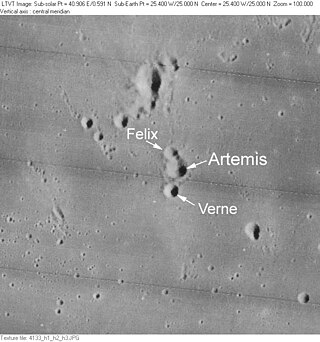
Artemis is a tiny lunar impact crater located in the Mare Imbrium. Craters of this dimension typically form cup-shaped excavations on the surface of the Moon. It lies near the midpoint between the craters Euler to the west and Lambert to the east. Just a few kilometers to the southeast is the even smaller Verne.
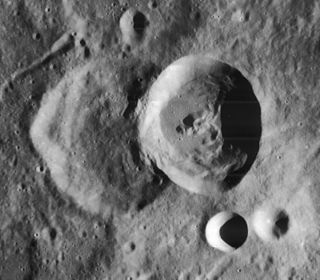
Sirsalis is a relatively young lunar impact crater located near the western lunar limb, to the southwest of the Oceanus Procellarum. The crater lies across a ridge that runs in a north–south direction. It has a sharp edge and a low central peak. The crater overlaps the slightly larger and older Sirsalis A to the west-southwest, and the two form a distinctive feature.

Ching-Te is a small lunar impact crater located in a mountainous area to the east of the Mare Serenitatis. It is a circular, bowl-shaped formation with no distinguishing features.

Segner is a lunar impact crater located near the southwestern limb of the Moon, to the northeast of the giant walled plain Bailly. The crater Zucchius is a few kilometers to the south-southwest of the rim, and to the north east lies the unusual formation Schiller. The smaller crater Weigel is located to the east.

Cauchy is a small lunar impact crater on the eastern Mare Tranquillitatis. It was named after French mathematician Augustin-Louis Cauchy. It is circular and symmetric, with a small interior floor at the midpoint of the sloping inner walls. Due to the high albedo of this bowl-shaped formation, it is particularly prominent at full Moon.

Furnerius is a large lunar impact crater located in the southeast part of the Moon, in the area close to the southeastern limb of the nearside or visible Moon. Because of its location, the crater appears oval in shape due to foreshortening but is actually nearly circular. Notable nearby craters include Stevinus to the northwest and Fraunhofer to the south-southwest. Farther to the northwest is the crater Snellius and the Vallis Snellius crater valley.
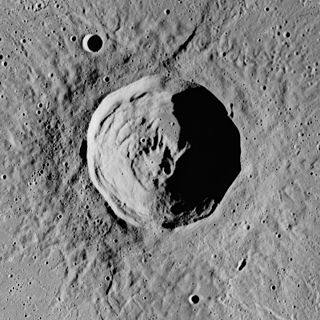
Lambert is a lunar impact crater on the southern half of the Mare Imbrium basin. It was named after Swiss polymath Johann Heinrich Lambert. It lies to the east and somewhat south of the slightly larger crater Timocharis. To the south is the smaller Pytheas, and some distance to the west-southwest is Euler.

Arrhenius is a lunar impact crater that is located just on the far side of the Moon, near the southwest limb. In this location the vicinity of the crater can be viewed during favorable librations, although it is viewed from on edge. To the south-southeast is the worn crater Blanchard, and De Roy lies further to the west.
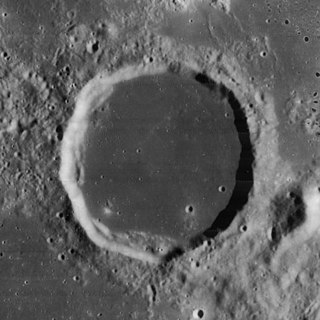
Billy is a lunar impact crater that is located at the southern fringes of the Oceanus Procellarum, in the western hemisphere of the Moon. It was named after French mathematician Jacques de Billy. It lies to the southeast of the similar-sized crater Hansteen, and west-southwest of the flooded Letronne.

Nishina is the remnant of a lunar impact crater that is located in the southern hemisphere on the far side of the Moon. It lies to the south-southwest of the crater Maksutov, to the southeast of Finsen and Leibniz.

Barkla is a lunar impact crater that lies near the eastern limb of the Moon. It is located to the east of the prominent crater Langrenus, and was formerly designated Langrenus A before being renamed by the IAU in 1979. Due east of Barkla is Kapteyn, a formation only slightly larger with a similar size. Southwest of Barkla is the crater Lamé.
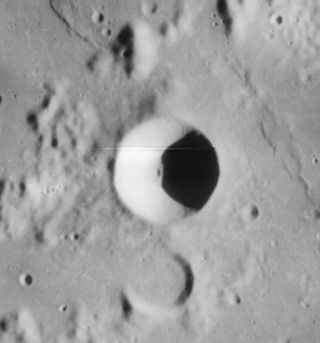
Darney is a small lunar impact crater that is located on the region of the Moon where the Mare Nubium joins the Oceanus Procellarum. It was named after French astronomer Maurice Darney. To the south is the lava-flooded crater Lubiniezky. The southern rim of Darney is attached to a series of low ridges that extend to the southwest.

Damoiseau is a lunar impact crater that is located just to the west of the Oceanus Procellarum, in the western part of the Moon's near side. It lies due east of the prominent crater Grimaldi, a walled plain with a distinctive dark floor. Due south of Damoiseau is the crater Sirsalis.

Daubrée is a lunar impact crater that is located to the southwest of the Mare Serenitatis, just to the west-southwest of the crater Menelaus in the Montes Haemus range. The small lunar mare Lacus Hiemalis lies along the southwest rim of Daubrée. The crater was named after French geologist Gabriel A. Daubrée. It was previously designated Menelaus S.

Courtney is a tiny lunar impact crater on the Mare Imbrium, a lunar mare in the northwest quadrant of the Moon. It lies about two crater diameters to the northwest of Euler, in an otherwise isolated stretch of the mare. The dark surface in this region is marked by Euler's ray material. The name is an English male name.

Dyson is a lunar impact crater, 63 kilometers in diameter, that lies on the far side of the Moon, past the northwest limb. It is located in the northern part of the surface, to the northwest of the crater Coulomb, and east of van't Hoff.

Eichstadt is a lunar impact crater that is located in the eastern section of the Montes Cordillera range that encircles the Mare Orientale impact basin. It lies toward the southwestern limb of the Moon, and so appears oblong when viewed from the Earth due to foreshortening. Over 200 kilometers to the east of Eichstadt are the craters Darwin and Lamarck, and to the south is Krasnov.
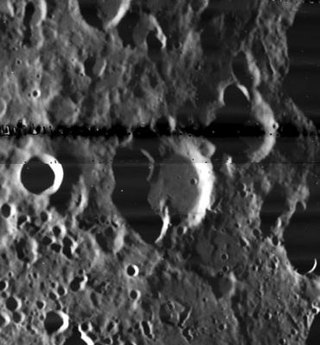
Douglass is a lunar impact crater on the far side of the Moon. It lies to the southwest of the crater Frost and south-southwest of the large walled plain Landau.

Mons Vinogradov is a rugged massif that is located on the lunar mare where Oceanus Procellarum to the southwest joins Mare Imbrium to the east. There are three primary peaks in this formation, which rise to altitudes of 1.0–1.4 km above the surface. To the east of this rise is the crater Euler, and to the southeast is an area of rugged ground that reaches the Montes Carpatus range. The Carpatus mountain range forms the southwest boundary of the Mare Imbrium.

Denning is a lunar impact crater that is located on the far side of the Moon. It lies about midway between the craters Levi-Civita to the south and Marconi to the north-northeast. About two crater diameters to the southeast is the huge walled plain Gagarin.
























